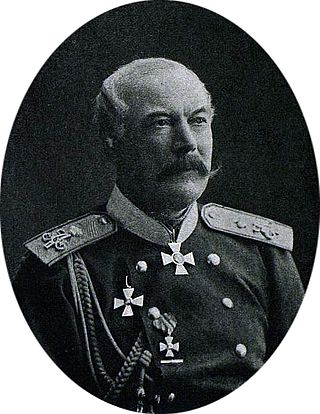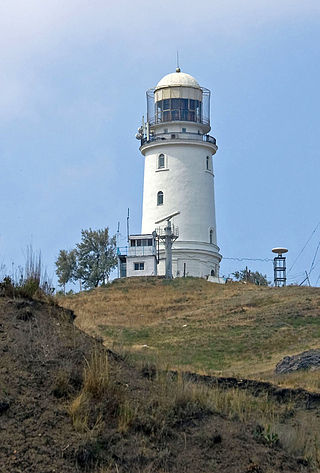
The Crimean War was fought from October 1853 to February 1856 between the Russian Empire and an ultimately victorious alliance of the Ottoman Empire, France, the United Kingdom, and Sardinia-Piedmont.

Kerch, also known as Keriç or Kerich, is a city of regional significance on the Kerch Peninsula in the east of Crimea. Kerch has a population of about 147,033 .

The Sea of Azov is an inland shelf sea in Eastern Europe connected to the Black Sea by the narrow Strait of Kerch, and is sometimes regarded as a northern extension of the Black Sea. The sea is bounded by Russia on the east, and by Ukraine on the northwest and southwest, currently under Russian occupation. It is an important access route for Central Asia, from the Caspian Sea via the Volga–Don Canal.

Crimea is a peninsula in Eastern Europe, on the northern coast of the Black Sea, almost entirely surrounded by the Black Sea and the smaller Sea of Azov. The Isthmus of Perekop connects the peninsula to Kherson Oblast in mainland Ukraine. To the east, the Crimean Bridge, constructed in 2018, spans the Strait of Kerch, linking the peninsula with Krasnodar Krai in Russia. The Arabat Spit, located to the northeast, is a narrow strip of land that separates the Syvash lagoons from the Sea of Azov. Across the Black Sea to the west lies Romania and to the south is Turkey. The largest city is Sevastopol. The region has a population of 2.4 million, and has been under Russian occupation since 2014.

The Kerch Strait is a strait in Eastern Europe. It connects the Black Sea and the Sea of Azov, separating the Kerch Peninsula of Crimea in the west from the Taman Peninsula of Russia's Krasnodar Krai in the east. The strait is 3.1 kilometres (1.9 mi) to 15 kilometres (9.3 mi) wide and up to 18 metres (59 ft) deep. The most important harbor, the Crimean city of Kerch, gives its name to the strait, formerly known as the Cimmerian Bosporus. It has also been called the Straits of Yenikale after the Yeni-Kale fortress in Kerch.

Yeni-Kale is a fortress on the shore of Kerch Strait in the city of Kerch.

Franz Eduard Graf von Tottleben, better known as Eduard Totleben in English, was a Baltic German military engineer and Imperial Russian Army general. He was in charge of fortification and sapping work during a number of important Russian military campaigns.

Kronstadt is a Russian port city in Kronshtadtsky District of the federal city of Saint Petersburg, located on Kotlin Island, 30 km (19 mi) west of Saint Petersburg, near the head of the Gulf of Finland. It is linked to the former Russian capital by a combination levee-causeway-seagate, the St Petersburg Dam, part of the city's flood defences, which also acts as road access to Kotlin island from the mainland.

The Azov campaigns of 1695–1696, were two Russian military campaigns during the Russo-Turkish War of 1686–1700, led by Peter the Great and aimed at capturing the Turkish fortress of Azov with the aim of controlling the southern mouth of the Don River gaining access to the Sea of Azov and entrance to the Black Sea. Despite stubborn resistance and heavy casualties, the Russians under General Sheremetev after a failed siege in 1695 managed to capture the fort, accompanied by a naval force, in July 1696, marking the first major Russian victory against the Turks.

The Russo-Turkish War of 1735–1739 between Russia and the Ottoman Empire was caused by the Ottoman Empire's war with Persia and continuing raids by the Crimean Tatars. The war also represented Russia's ongoing struggle for access to the Black Sea. In 1737, the Habsburg monarchy joined the war on Russia's side, known in historiography as the Austro-Turkish War of 1737–1739.

The southern Russian city of Taganrog began as one of Russia's first planned cities under Peter the Great. To protect the newly conquered Sea of Azov region, the Russians opened a naval base there in 1698 and a city and seaport were built. However, after the Turkish victory in the war of 1710–1711, Taganrog city and port were demolished prior to handover to the Turks.

The Kerch Peninsula is a major and prominent geographic peninsula located at the eastern end of the Crimean Peninsula.

The Battle of the Kerch Peninsula, which commenced with the Soviet Kerch-Feodosia Landing Operation and ended with the German Operation Bustard Hunt, was a World War II battle between Erich von Manstein's German and Romanian 11th Army and the Soviet Crimean Front forces in the Kerch Peninsula, in the eastern part of the Crimean Peninsula. It began on 26 December 1941, with an amphibious landing operation by two Soviet armies intended to break the Siege of Sevastopol. Axis forces first contained the Soviet beachhead throughout the winter and interdicted its naval supply lines through aerial bombing. From January through April, the Crimean Front launched repeated offensives against the 11th Army, all of which failed with heavy losses. The Red Army lost 352,000 men in the attacks, while the Axis suffered 24,120 casualties. Superior German artillery firepower was largely responsible for the Soviet debacle.

The 383rd 'Miners' Rifle Division was a formation of the Red Army, created during the Second World War. The division was officially created on 18 August 1941. It was given the name Shakhterskaya, as it was originally composed completely of miners from the Donets Basin, Ukrainian SSR. During the course of the war, its losses were continually replaced, and thus it began to consist not only of miners from Donbas.

The Crimean Bridge, also called Kerch Strait Bridge or Kerch Bridge, is a pair of parallel bridges, one for a four-lane road and one for a double-track railway, spanning the Kerch Strait between the Taman Peninsula of Krasnodar Krai in Russia and the Kerch Peninsula of Crimea. Built by the Russian Federation after its annexation of Crimea at the start of 2014, the bridge cost ₽227.92 billion (US$3.7 billion) and has a length of 19 km (12 mi), making it the longest bridge in Europe and the longest bridge ever constructed by Russia.
The Separate Coastal Army, also translated to English as Independent Coastal Army, was an army-level unit in the Red Army that fought in World War II. It was established on July 18, 1941, by the order of the Southern Front from the forces of 9th Army’s Coastal Group and was stood up on July 20, 1941.

The Arabat Fortress, built in the 17th century by the Ottoman army, stands at the southernmost part of the Arabat Spit. Its purpose was to guard the spit and Crimea from invasions. It was in use, with intermissions, until the Crimean War of 1853–1856.

The Yeni Kale Lighthouse is an active lighthouse on Cape Fonar near Yeni-Kale fortress in eastern Crimea on the shore of Kerch Strait. Navigation cressets on this coast were first mentioned in the Periplus of Scylax, dated 350 BC.

The territory of Crimea, previously controlled by the Crimean Khanate, was annexed by the Russian Empire on 19 April [O.S. 8 April] 1783. The period before the annexation was marked by Russian interference in Crimean affairs, a series of revolts by Crimean Tatars, and Ottoman ambivalence. The annexation began 134 years of rule by the Russian Empire, which was ended by the revolution of 1917. The annexation resulted in the end of the Crimean slave trade, which had been one of the major slave trades from Europe for centuries.

The 390th Rifle Division was an infantry division of the Soviet Union's Red Army during World War II. It was formed twice, first in August 1941, and after its destruction in 1942, re-formed in 1944.































